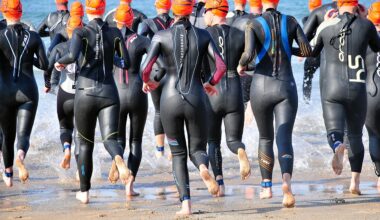Improving Hip Mobility Through Targeted Foam Rolling Techniques
Hip mobility is essential for overall body movement, contributing to flexibility and reducing injury risks. Notably, foam rolling serves as an effective self-myofascial release technique that enhances blood circulation and muscle recovery. This approach aids in alleviating tightness in the hip muscles, which can lead to better performance in various physical activities. Utilizing foam rolling can be particularly beneficial for individuals engaged in sports, fitness routines, or even those with sedentary lifestyles. To start improving hip mobility, choosing the right foam roller is critical. Density and texture can significantly influence effectiveness based on personal comfort levels and muscle tension. It is advisable to use a medium-density foam roller for beginners, as this provides a balance between discomfort and relief. Additionally, incorporating targeted rolling techniques can optimize the mobility-enhancing benefits. The goal is to apply pressure to specific areas, allowing for relaxation and improved range of motion over time. Therefore, including foam rolling into your regular workout regimen can yield remarkable improvements in hip flexibility and contribute to better overall mobility.
Understanding the Anatomy of the Hip
To effectively use foam rolling for mobility, understanding hip anatomy is essential. The hip joint comprises several key muscles, including the psoas, gluteus maximus, and iliotibial band. Each muscle plays a vital role in hip function, including stabilizing the pelvis and facilitating leg movement. Foam rolling targets these muscles, addressing tension and promoting elasticity. The psoas, in particular, is often tight due to prolonged sitting. Releasing tension in this area improves hip flexor mobility, essential for activities like squatting and running. On the other hand, the gluteus maximus is critical for power generation. Tightness here can limit an individual’s ability to extend their hip properly when running, cycling, or climbing stairs. Meanwhile, the iliotibial band supports lateral stability during movement. Regular foam rolling helps release this doling tightness, improves overall hip stability, and can reduce pain associated with conditions like IT band syndrome. Thus, knowing your anatomy can enhance foam rolling effectiveness and lead to substantial mobility improvements.
To begin foam rolling for hip mobility, it is advisable to incorporate specific techniques tailored to effectively target the surrounding muscle groups. Start with the glutes, by sitting on the foam roller and gently leaning to one side, rolling from the sacrum to the top of the glute muscles. This practice helps alleviate tightness and enhance blood flow. Next, transition to the hip flexors, positioning the roller directly under the hip and rolling back and forth along the psoas region. Be cautious with pressure, especially if you experience discomfort, and adjust accordingly. This technique promotes relaxation in one of the primary muscles contributing to hip flexion. It’s also beneficial to roll along the IT band by lying on the side with the roller positioned along the outer thigh. Although this area may be sensitive, gently rolling along the band encourages flexibility and reduces strain during activities. Lastly, integrate a stretching routine following the foam rolling session to maximize beneficial effects. Doing so helps maintain the increased range of motion achieved through foam rolling.
Incorporating Foam Rolling into Your Routine
Making foam rolling a consistent part of your physical regimen is crucial for enhancing hip mobility. Aim to foam roll at least two to three times a week, particularly before and after workouts. This practice prepares the muscles for movement and assists in recovery post-activity. It’s key to dedicate around 5 to 10 minutes during each session exclusively to hip-focused rolling. For optimal results, focus on quality over quantity; spending additional time on particularly tight areas may yield better outcomes than rushing through the entire routine. Additionally, combining foam rolling with dynamic stretching before workouts can further enhance mobility. Dynamic stretches activate muscle groups and alleviate stiffness resulting from foam rolling. After workouts, perform static stretches combined with foam rolling to further improve elasticity and maintain the relaxed state of the muscles. Notably, consistency and patience are vital; changes in mobility may take time but will significantly improve performance in the long run. Focus on listening to the body and adjusting techniques based on personal experience and comfort levels.
Foam rolling not only benefits hip mobility but can also alleviate discomfort associated with tightness in the lower back and legs. As such, incorporating a comprehensive approach is essential. Starting your routine with deep breathing can prepare your mind and body for effective rolling. Take a moment to focus on inhaling and exhaling deeply, allowing yourself to become grounded. This practice helps in tension release and promotes a stronger mind-muscle connection. Keep mindful of your body’s feedback when rolling; if a point feels particularly sensitive, consider holding pressure on that area for a few seconds. This technique can facilitate the release of knots and trigger points. Following the hip area, rolling the lower back by positioning the roller under the lower lumbar region can offer significant relief. Adjust body positioning to ensure comfort and prevent strain. Lastly, remember that foam rolling should not provoke excessive pain; instead, it should feel like a soothing release. Establishing a holistic routine can lead to long-term improvements in mobility and overall physical well-being.
Common Mistakes to Avoid
When engaging in foam rolling, it’s crucial to avoid common mistakes that can hinder mobility improvement and potentially cause injury. One frequent error is applying excessive pressure on tender areas. Rather than forcing through pain, focus on gradual pressure application to allow muscles to gradually release tension. Ensure that the foam roller is in motion rather than static on a sensitive spot, as lingering too long on certain areas can lead to soreness or bruising. Equally important is maintaining proper body alignment; rolling with poor postural alignment may create additional strain or discomfort. Always engage your core and keep a neutral spine while rolling. Additionally, avoiding rushed movements is essential; performing foam rolling with intent rather than haste allows the muscles to comprehend and react appropriately to the applied pressure. Lastly, neglecting the rest of the body when focusing solely on the hips can lead to imbalances. Comprehensive mobility work should include focus on intertwined muscle groups, ensuring an overall balanced approach to mobility improvements.
In summary, foam rolling for hip mobility offers a realistic and effective solution to enhance flexibility and movement efficiency. Undoubtedly, the technique can contribute significantly to athletic performance and day-to-day activities. As previously mentioned, targeting specific muscle groups surrounding the hips is crucial for reaping the full benefits of foam rolling. Consistency also plays a vital role; integrating foam rolling into your routine can create lasting improvements and prevent recurrent tightness. Moreover, understanding the anatomy of the hips provides insight into where to focus efforts, further building up your expertise. Indeed, breathing techniques aiding the process can enhance the overall experience when rolling. Moreover, being aware of common mistakes ensures optimal alignment and reduces the risk of injury. Lastly, consider consulting with a fitness expert to refine your technique if you are uncertain. Proper guidance, combined with personalized adjustments, can yield substantial improvements. Embrace this self-care routine to keep your hips healthy and mobile, allowing you to pursue your fitness goals effectively and safely. With time, your improved hip mobility can lead to more efficient movement patterns and overall well-being.



